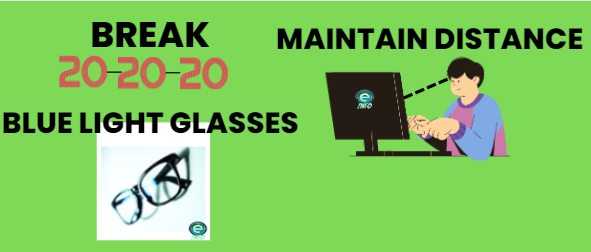What is Computer Vision Syndrome : Hey friends, we all love our eyes and want to see more unseen things with our eyes, but now a days we are working in a digital world where from wake up till sleep we are on computer/mobile, television and other technologies.
Despite the incredible strides made in the digital realm our health has been somewhat neglected leading to the emergence of numerous symptoms. In this blog we will discuss about “What is Computer Vision Syndrome”.

Table of Contents
What is Computer Vision Syndrome
Computer vision syndrome (CVS) is a condition resulting from focused vision on a computer screen for protracted, uninterrupted periods of time. CVS includes a group of eye and vision-related problems that result from prolonged computer use.

Although certain individuals may only encounter mild CVS symptoms, others may struggle with working on their computer for more than a couple of hours without facing significant discomfort. It’s heartening to know that there are ways to mitigate the symptoms of CVS and improve your overall experience while operating the computer.
If you find yourself suffering from any of the following symptoms after spending time staring at a computer screen, you may be experiencing what is commonly referred to as “computer vision syndrome”:
- Eye strain
- Blurred vision
- Dry eyes
- Headaches
- Neck and shoulder pain

How Common is Computer Vision Syndrome
Computer vision syndrome (CVS) is a condition that’s caused by extended use of computers and other electronic devices. The symptoms of CVS include eye strain, headaches, blurred vision, and neck and shoulder pain.
While there’s no exact number of how many people suffer from CVS, a survey conducted by the American Optometric Association found that 65% of adults who work on a computer all day experience at least one symptom of the condition. So it’s safe to say that CVS is quite common.

There are a few factors that contribute to the development of CVS. One is the way we view computers and other electronic screens. We tend to look at them at a downward angle, which puts strain on our necks and shoulders. Another factor is the level of lighting in the room. If it’s too bright or too dark, it can cause our eyes to work harder than they need to.
Fortunately, there are things you can do to help prevent or relieve the symptoms of CVS. Some simple tips include:
- Taking breaks often to give your eyes a rest
- Adjusting the lighting in your room so it’s not too bright or too dark
- Making sure the screen of your computer is at eye level
- Wearing glasses or contacts if you need them
How to Fix Computer Vision Syndrome
While the symptoms of CVS can be annoying, they are usually not permanent or serious. But, if you encounter any of these signs frequently, it is crucial to take precautions to safeguard your vision.
There are a number of things you can do to prevent or reduce the symptoms of CVS, including:
- Taking breaks often to give your eyes a rest
- Adjusting the lighting in your work area
- Wearing computer glasses or contact lenses specifically designed for use with computers
- Making sure the screen of your computer is at the correct level and distance from your eyes
If you experience symptoms of computer vision syndrome (CVS), take a break from your screen every 20 minutes to look at something 20 feet away for 20 seconds. Try the 10-10-10 rule: every 10 minutes, take 10 seconds to look at something 10 feet away.

- If you work at a computer all day, practice the 20-20-20 rule to reduce your risk of CVS:
- Every 20 minutes, look at an object 20 feet away for 20 seconds.
blue light glasses may help. Blue light glasses have a special filter that blocks blue light from screens. This can help reduce eye fatigue and strain.
Blue Light Glasses for Computer Vision Syndrome
One option is to wear special glasses that are designed to reduce eye strain when working at a computer. These glasses typically have a blue light filter that helps to reduce the amount of blue light that reaches your eyes. This can help to reduce the amount of eye fatigue and strain that you experience. Additionally, these glasses may also have a magnification feature that can help you to see the screen more clearly. If you wear contact lenses, you may want to consider switching to glasses when working at a computer to help reduce the risk of CVS
<If you spend a lot of time working at a computer, talk to your doctor about whether special glasses would be right for you.>
Hope you FIND ” What is Computer Vision Syndrome” & Stay connected with us for more effective and working ideas. follow us on twitter.com/einfonett

